Potential of Virtual Earth Observation Constellations in Archaeological Research
Abstract
:1. Introduction
2. CEOS Virtual Constellations Concept
3. Virtual Constellations in Archaeological Research
3.1. Area of Interest
3.2. Data Description and Methodology
3.3. Data Analysis
4. Discussion
5. Conclusions
Author Contributions
Funding
Acknowledgments
Conflicts of Interest
References
- Xia, J.; Yang, C.; Li, Q. Building a spatiotemporal index for Earth Observation Big Data. Int. J. Appl. Earth Obs. Geoinf. 2018, 73, 245–252. [Google Scholar] [CrossRef]
- Agapiou, A.; Sarris, A. Beyond GIS Layering: Challenging the (Re)use and Fusion of Archaeological Prospection Data Based on Bayesian Neural Networks (BNN). Remote Sens. 2018, 10, 1762. [Google Scholar] [CrossRef]
- González, J.J.F.; Hernández, F.R.V. NDVI Identification and Survey of a Roman Road in the Northern Spanish Province of Álava. Remote Sens. 2019, 11, 725. [Google Scholar] [CrossRef]
- Luo, L.; Wang, X.; Lasaponara, R.; Xiang, B.; Zhen, J.; Zhu, L.; Yang, R.; Liu, D.; Liu, C. Auto-Extraction of Linear Archaeological Traces of Tuntian Irrigation Canals in Miran Site (China) from Gaofen-1 Satellite Imagery. Remote Sens. 2018, 10, 718. [Google Scholar] [CrossRef]
- Mineo, S.; Pappalardo, G.; Mangiameli, M.; Campolo, S.; Mussumeci, G. Rockfall Analysis for Preliminary Hazard Assessment of the Cliff of Taormina Saracen Castle (Sicily). Sustainability 2018, 10, 417. [Google Scholar] [CrossRef]
- Caspari, G. Assessing Looting from Space: The Destruction of Early Iron Age Burials in Northern Xinjiang. Heritage 2018, 1, 320–327. [Google Scholar] [CrossRef] [Green Version]
- Agapiou, A.; Lysandrou, V.; Hadjimitsis, D.G. Optical Remote Sensing Potentials for Looting Detection. Geosciences 2017, 7, 98. [Google Scholar] [CrossRef]
- Borie, C.; Parcero-Oubiña, C.; Kwon, Y.; Salazar, D.; Flores, C.; Olguín, L.; Andrade, P. Beyond Site Detection: The Role of Satellite Remote Sensing in Analysing Archaeological Problems. A Case Study in Lithic Resource Procurement in the Atacama Desert, Northern Chile. Remote Sens. 2019, 11, 869. [Google Scholar] [CrossRef]
- Cigna, F.; Tapete, D. Tracking Human-Induced Landscape Disturbance at the Nasca Lines UNESCO World Heritage Site in Peru with COSMO-SkyMed InSAR. Remote Sens. 2018, 10, 572. [Google Scholar] [CrossRef]
- Tapete, D.; Cigna, F. COSMO-SkyMed SAR for Detection and Monitoring of Archaeological and Cultural Heritage Sites. Remote Sens. 2019, 11, 1326. [Google Scholar] [CrossRef]
- Cigna, F.; Lasaponara, R.; Masini, N.; Milillo, P.; Tapete, D. Persistent Scatterer Interferometry Processing of COSMO-SkyMed StripMap HIMAGE Time Series to Depict Deformation of the Historic Centre of Rome, Italy. Remote Sens. 2014, 6, 12593–12618. [Google Scholar] [CrossRef] [Green Version]
- Tapete, D.; Cigna, F.; Donoghue, D.N. ‘Looting marks’ in space-borne SAR imagery: Measuring rates of archaeological looting in Apamea (Syria) with TerraSAR-X Staring Spotlight. Remote Sens. Environ. 2016, 178, 42–58. [Google Scholar] [CrossRef]
- Stewart, C. Detection of Archaeological Residues in Vegetated Areas Using Satellite Synthetic Aperture Radar. Remote Sens. 2017, 9, 118. [Google Scholar] [CrossRef]
- Luo, L.; Wang, X.; Guo, H.; Lasaponara, R.; Zong, X.; Masini, N.; Wang, G.; Shi, P.; Khatteli, H.; Chen, F.; et al. Airborne and spaceborne remote sensing for archaeological and cultural heritage applications: A review of the century (1907–2017). Remote Sens. Environ. 2019, 232, 111280. [Google Scholar] [CrossRef]
- Agapiou, A.; Lysandrou, V. Remote Sensing Archaeology: Tracking and mapping evolution in scientific literature from 1999–2015. J. Archaeol. Sci. Rep. 2015, 4, 192–200. [Google Scholar] [CrossRef]
- Wulder, M.A.; Hilker, T.; White, J.C.; Coops, N.C.; Masek, J.G.; Pflugmacher, D.; Crevier, Y. Virtual constellations for global terrestrial monitoring. Remote Sens. Environ. 2015, 170, 62–76. [Google Scholar] [CrossRef] [Green Version]
- CEOS—Committee on Earth Observation Satellites. Available online: http://ceos.org/ourwork/virtual-constellations/ (accessed on 8 January 2019).
- Kvamme, K.L. Geophysical correlation: Global versus local perspectives. Archaeol. Prospect. 2018, 25, 111–120. [Google Scholar] [CrossRef]
- Agapiou, A.; Lysandrou, V.; Sarris, A.; Papadopoulos, N.; Hadjimitsis, D.G. Fusion of Satellite Multispectral Images Based on Ground-Penetrating Radar (GPR) Data for the Investigation of Buried Concealed Archaeological Remains. Geosciences 2018, 7, 40. [Google Scholar] [CrossRef]
- Malfitana, D.; Leucci, G.; Fragalà, G.; Masini, N.; Scardozzi, G.; Cacciaguerra, G.; Santagati, C.; Shehi, E. The potential of integrated GPR survey and aerial photographic analysis of historic urban areas: A case study and digital reconstruction of a Late Roman villa in Durrës (Albania). J. Archaeol. Sci. Rep. 2015, 4, 276–284. [Google Scholar] [CrossRef]
- Sarris, A.; Papadopoulos, N.; Agapiou, A.; Salvi, M.C.; Hadjimitsis, D.G.; Parkinson, A.; Yerkes, R.W.; Gyucha, A.; Duffy, R.P. Integration of geophysical surveys, ground hyperspectral measurements, aerial and satellite imagery for archaeological prospection of prehistoric sites: The case study of Vészt˝o-Mágor Tell, Hungary. J. Archaeol. Sci. 2013, 40, 1454–1470. [Google Scholar] [CrossRef]
- Kvamme, K.L. Integrating multidimensional geophysical data. Archaeol. Prospect. 2006, 13, 57–72. [Google Scholar] [CrossRef]
- Traviglia, A.; Cottica, D. Remote sensing applications and archaeological research in the Northern Lagoon of Venice: The case of the lost settlement of Constanciacus. J. Archaeol. Sci. 2011, 38, 2040–2050. [Google Scholar] [CrossRef]
- CEOS Database. Available online: http://database.eohandbook.com/database/agencytable.aspx (accessed on 8 January 2019).
- Luo, L.; Wang, X.; Guo, H.; Lasaponara, R.; Shi, P.; Bachagha, N.; Li, L.; Yao, Y.; Masini, N.; Chen, F.; et al. Google Earth as a Powerful Tool for Archaeological and Cultural Heritage Applications: A Review. Remote Sens. 2018, 10, 1558. [Google Scholar] [CrossRef]
- Tapete, D.; Cigna, F. Trends and perspectives of SAR remote sensing for landscape archaeology and cultural heritage applications. J. Archaeol. Sci. Rep. 2017, 14, 716–726. [Google Scholar]
- Engelsk, H. Space Time Place Third International Conference on Remote Sensing in Archaeology 17th-21st August 2009 Tiruchirappalli Tamil Nadu India; BAR International Series 2118; Campana, S., Forte, M., Liuzza, C., Eds.; BAR Publishing: Oxford, UK, 2010; p. 451. [Google Scholar]
- Claverie, M.; Ju, J.; Masek, J.G.; Dungan, J.L.; Vermote, E.F.; Roger, J.-C.; Skakun, S.V.; Justice, C. The Harmonized Landsat and Sentinel-2 surface reflectance data set. Remote Sens. Environ. 2018, 219, 145–161. [Google Scholar] [CrossRef]
- Vouzaxakis, Κ. Geographical Patterns and Theories of the Inter-settlement Space at Neolithic Thessaly. Ph.D. Thesis, Aristotle University of Thessaloniki, Thessaloniki, Greece, 2009. Unpublished Doctoral Dissertation (In Greek). [Google Scholar]
- Alexakis, D.; Sarris, A.; Astaras, T.; Albanakis, K. Integrated GIS, remote sensing and geomorphologic approaches for the reconstruction of the landscape habitation of Thessaly during the neolithic period. J. Archaeol. Sci. 2011, 38, 89–100. [Google Scholar] [CrossRef]
- Alexakis, D.; Sarris, A.; Astaras, T.; Albanakis, K. Detection of Neolithic Settlements in Thessaly (Greece) Through Multispectral and Hyperspectral Satellite Imagery. Sensors 2009, 9, 1167–1187. [Google Scholar] [CrossRef] [Green Version]
- Kalaycı, T.; Sarris, A. Multi-Sensor Geomagnetic Prospection: A Case Study from Neolithic Thessaly, Greece. Remote Sens. 2016, 8, 966. [Google Scholar] [CrossRef]
- Kalayci, T.; Simon, F.-X.; Sarris, A. A Manifold Approach for the Investigation of Early and Middle Neolithic Settlements in Thessaly, Greece. Geosciences 2017, 7, 79. [Google Scholar] [CrossRef]
- Sentinel-Hub, EO Browser. Available online: https://www.sentinel-hub.com/explore/eobrowser (accessed on 25 April 2019).
- Agapiou, A.; Hadjimitsis, D.G.; Sarris, A.; Georgopoulos, A.; Alexakis, D.D. Optimum temporal and spectral window for monitoring crop marks over archaeological remains in the Mediterranean region. J. Archaeol. Sci. 2013, 40, 1479–1492. [Google Scholar] [CrossRef]
- Rouse, J.W.; Haas, R.H.; Schell, J.A.; Deering, D.W.; Harlan, J.C. Monitoring the Vernal Advancements and Retrogradation (Greenwave Effect) of Nature Vegetation; NASA/GSFC Final Report; NASA: Greenbelt, MD, USA, 1974.
- Agapiou, A.; Alexakis, D.D.; Sarris, A.; Hadjimitsis, D.G. Evaluating the Potentials of Sentinel-2 for Archaeological Perspective. Remote Sens. 2014, 6, 2176–2194. [Google Scholar] [CrossRef] [Green Version]
- Gao, B.-C. NDWI—A normalized difference water index for remote sensing of vegetation liquid water from space. Remote Sens. Environ. 1996, 58, 257–266. [Google Scholar] [CrossRef]
- Khanmohammadi, F.; Homaee, M.; Noroozi, A.A. Soil moisture estimating with NDVI and land surface temperature and normalized moisture index using MODIS images. J. Soil Water Resour. Conserv. 2015, 4, 37–45. [Google Scholar]
- Keay, J.S.; Parcak, H.S.; Strutt, D.K. High resolution space and ground-based remote sensing and implications for landscape archaeology: The case from Portus, Italy. J. Archaeol. Sci. 2014, 52, 277–292. [Google Scholar] [CrossRef]
- Lasaponara, R.; Masini, N. Detection of archaeological crop marks by using satellite QuickBird multispectral imagery. J. Archaeol. Sci. 2007, 34, 214–221. [Google Scholar] [CrossRef]
- Orengo, H.A.; Petrie, C.A. Large-Scale, Multi-Temporal Remote Sensing of Palaeo-River Networks: A Case Study from Northwest India and its Implications for the Indus Civilisation. Remote Sens. 2017, 9, 735. [Google Scholar] [CrossRef]
- Agapiou, A. Remote Sensing Heritage in a petabyte-scale: Satellite Data and Heritage Earth Engine© applications. Int. J. Digit. Earth 2017, 10, 85–102. [Google Scholar] [CrossRef]
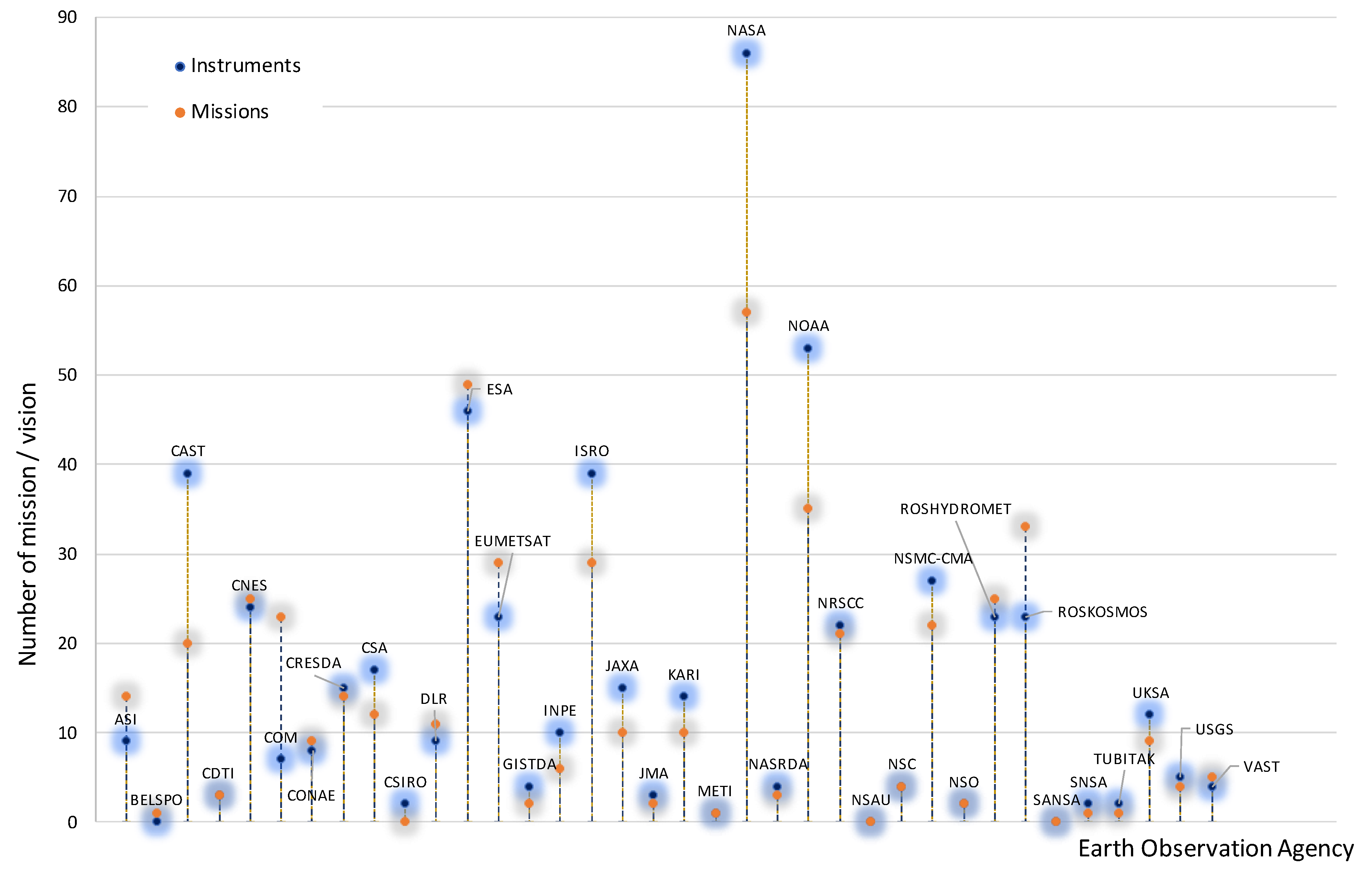
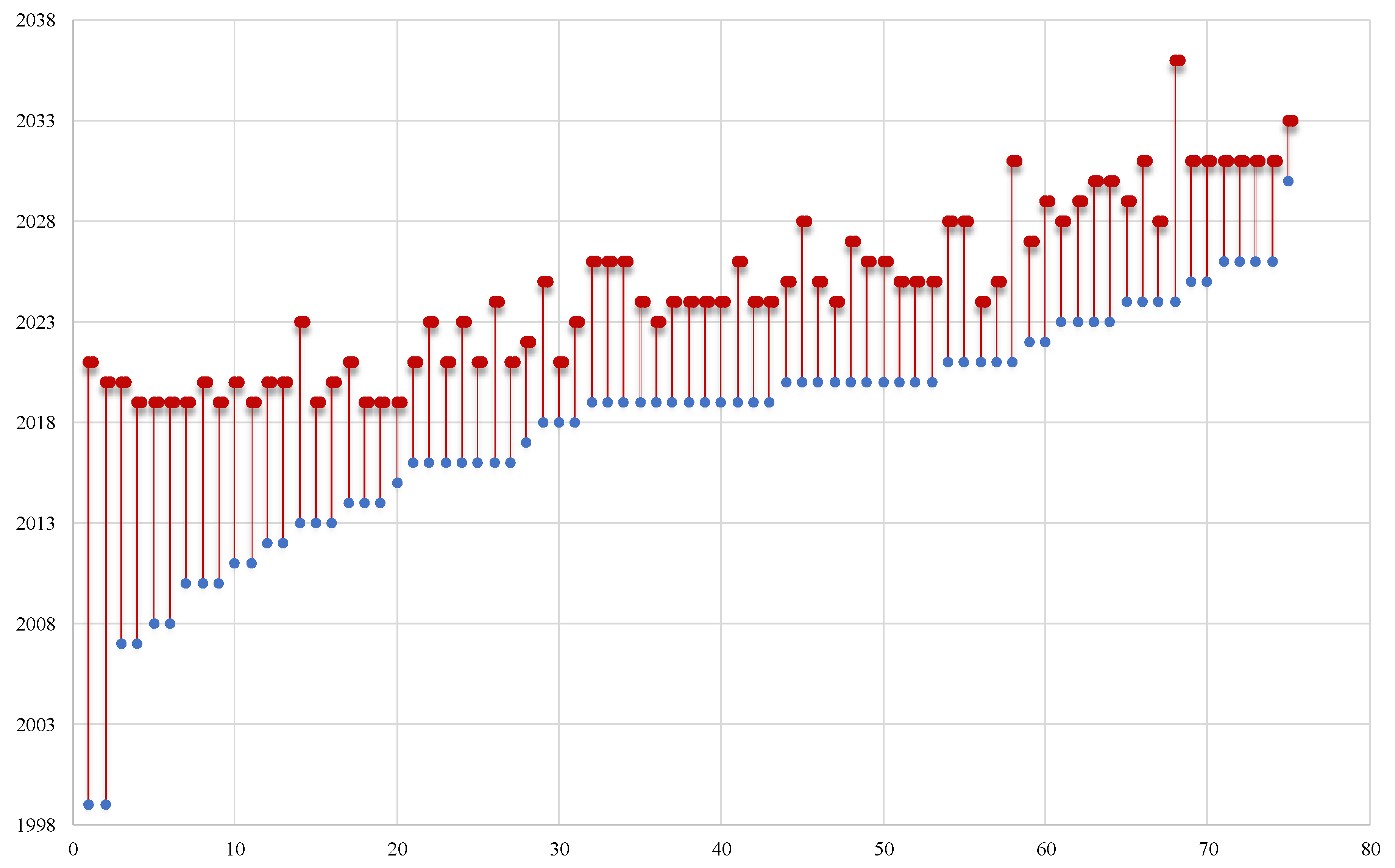
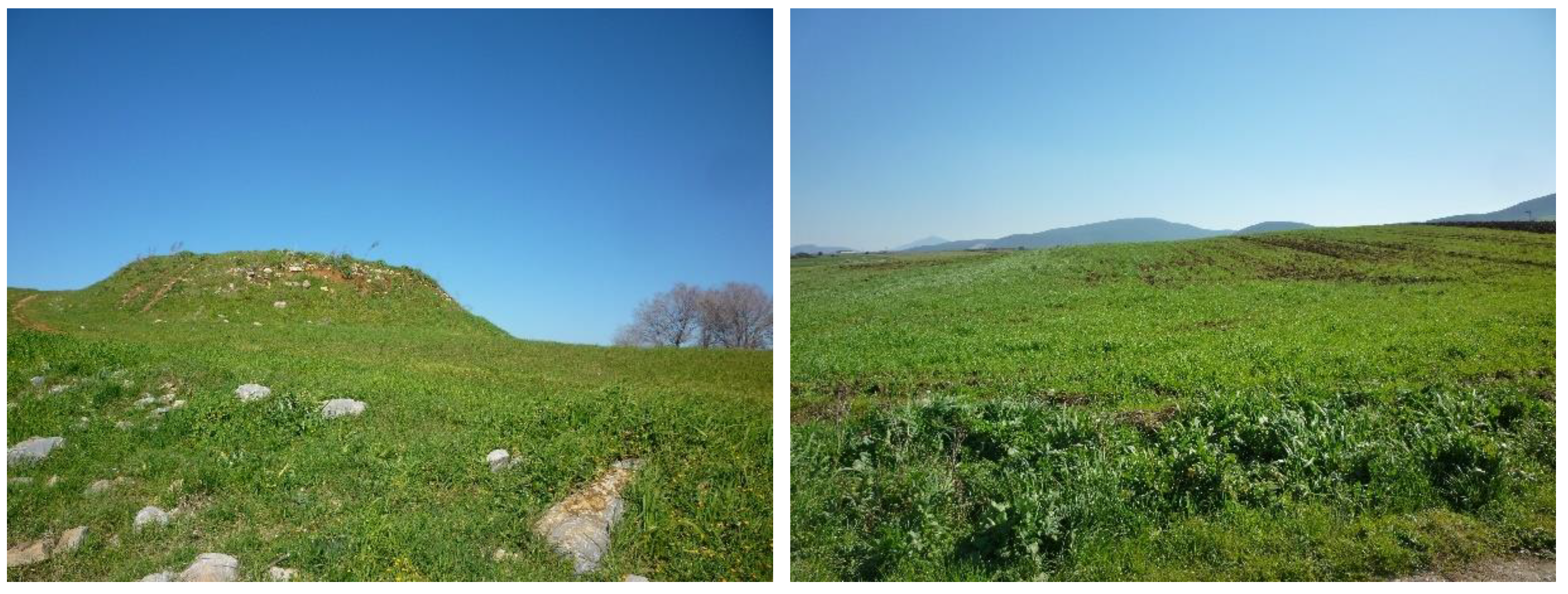

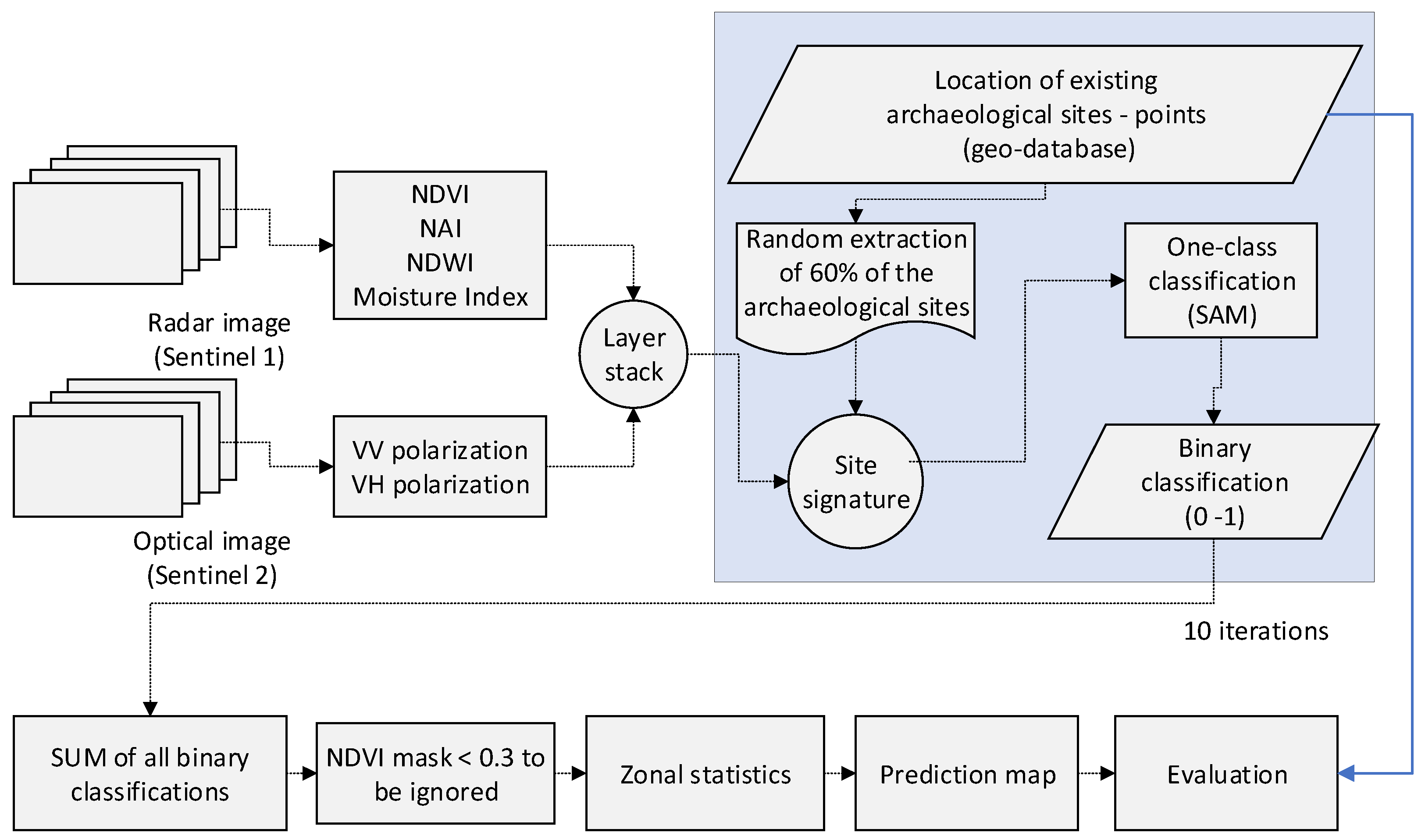

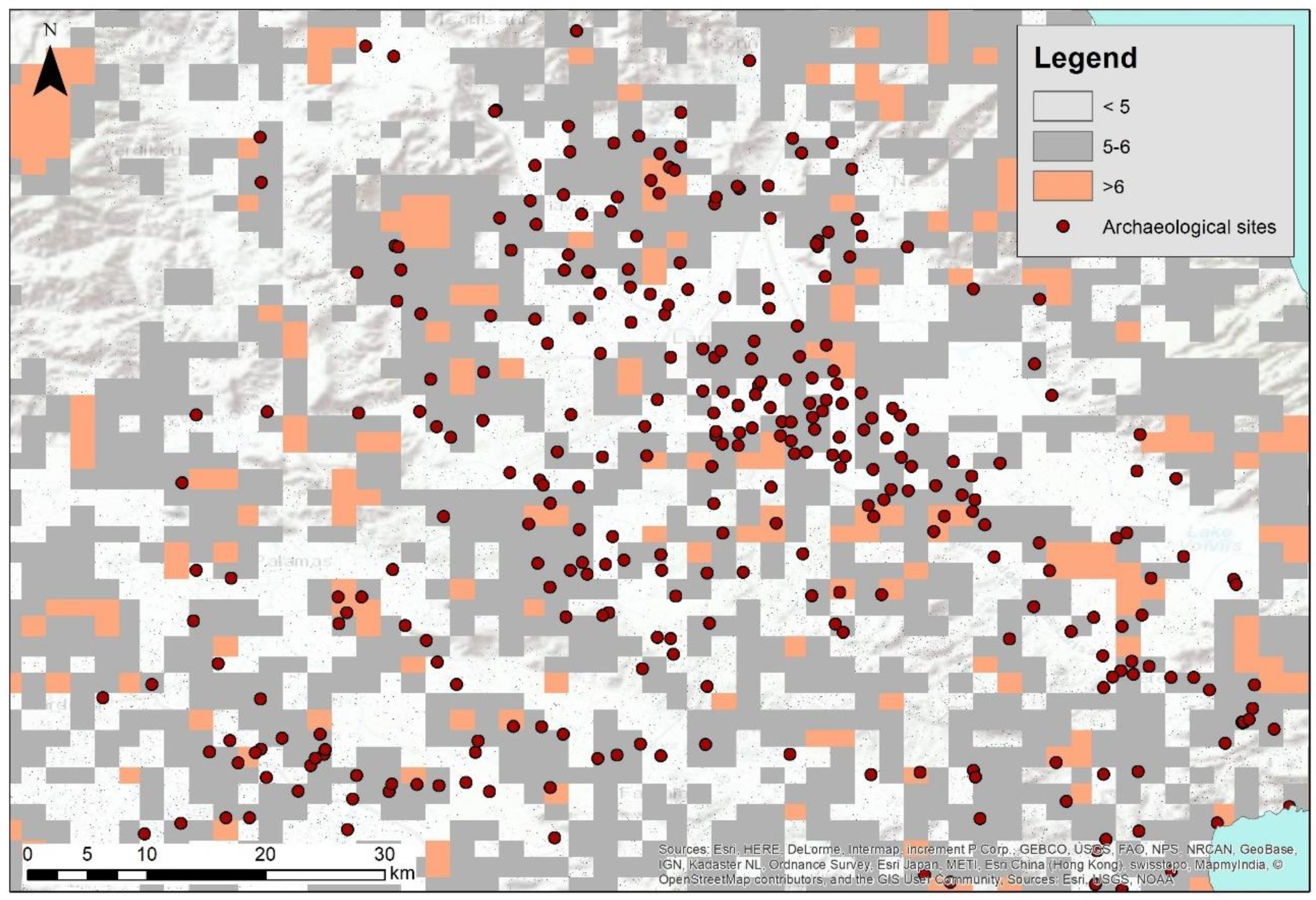
| Instrument Sort and Full Name | Agencies/Country | Instrument Status * | Wavelength | Resolution (m) | Data Access ** |
|---|---|---|---|---|---|
| AEISS—Advanced Electronic Image Scanning System | KARI/Korea (ASTRIUM/Europe) | O | VIS, NIR | Pan: 0.7 m VNIR: 2.8 m | VCA |
| AEISS-A—Advanced Electronic Image Scanning System-A | KARI/Korea (ASTRIUM/Europe) | O | VIS, NIR, MWIR | Pan: 0.7 m VNIR: 2.8 m IR: 5.5 m | VCA |
| AEISS-HR—Advanced Electronic Image Scanning System-High Resolution | KARI/Korea (KAI) | F | VIS, NIR | Pan: 0.5 m, VNIR: 2 m | VCA |
| APAN—Advanced PAN | ISRO/India | F | VIS | 1.25 | CA |
| ASTER—Advanced Spaceborne Thermal Emission and Reflection Radiometer | METI/India (NASA)/USA | O | VIS, NIR, SWIR, TIR | VNIR: 15 m SWIR: 30 m TIR: 90 m | OA |
| ATCOR—Atmospheric correction | ISRO/India | F | VIS, NIR | 240 m | CA |
| CARBONITE-1 Imager | UKSA/UK | O | VIS | 1.5 m | VCA |
| CARBONITE-2 Imager | UKSA/UK | O | VIS | 1.2 m | VCA |
| CCD (HJ) | CAST/China | O | VIS, NIR | 30 m | OA |
| Event Imaging Spectrometer from GEO (GeoCape) | NASA/USA | F | VIS | 250 m | OA |
| Geoton-L1 | ROSKOSMOS/Russia | O | VIS, NIR | 1 m; 3 m | CA |
| High Resolution Optical Sensor | KARI/Korea | F | VIS, NIR | 1m | VCA |
| HiRI—High-Resolution Imager | CNES/France | O | VIS, NIR | 0.70 m | OA |
| LISS-III—Linear Imaging Self Scanner III (Resourcesat) | ISRO/India | O | VIS, NIR, SWIR | 23.5 m | OA |
| LISS-IV | ISRO/India | O | VIS, NIR | 5.8 m | CA |
| LISS-V—Linear Imaging Self Scanner – IV | ISRO/India | F | VIS | 2.5 | CA |
| MSC—Multi-Spectral Camera | KARI/Korea | O | VIS, NIR | Pan: 1 m VIS-NIR: 4 m | VCA |
| MSI—Multi Spectral Imager | DLR/Germany | O | VIS, NIR | 6.5 m | OA |
| MSI (Sentinel-2)—Multi-Spectral Instrument | ESA/Europe (COM/Europe) | O | VIS, SWIR | 10/20 m | OA |
| MSS—Multispectral imaging system | ROSKOSMOS/Russia (ROSHYDROMET/Russia) | O | VIS, NIR | 12 m | CA |
| MUX (SJ-9A)—Multispectral CCD Camera | CRESDA/China | O | VIS, NIR | 10 m | OA |
| MX (HRSAT)—Multispectral HR VNIR | ISRO/India | F | VIS | 1.9 m | CA |
| NigeriaSat 2 Remote Sensing—Med and High Res | NASRDA/Nigeria | O | VIS, NIR | Pan: 2.5 m MS: 5/32 m | |
| OEK VR—Multispectral optoelectronic high-resolution module | ROSKOSMOS/Russia | F | VIS, NIR | Pan: 0.4 m MS: 1.6 m | CA |
| PAN (BJ-2)—Panchromatic Imager | NRSCC/China | O | VIS | 1 m | |
| PAN (Cartosat-1)—Panchromatic Camera | ISRO/India | O | VIS | 2.5 m | CA |
| PAN (Cartosat-2)—Panchromatic Camera | ISRO/India | O | VIS | 1 m | VCA |
| PAN (Cartosat-2A/2B)—Panchromatic Camera | ISRO/India | O | VIS | 1 m | VCA |
| PAN (Cartosat-2E)—Panchromatic Camera | ISRO/India | O | VIS | 0.65 m | VCA |
| PAN (Cartosat-3)—Panchromatic sensor | ISRO/India | F | VIS | 0.25 m | VCA |
| PAN (CBERS)—Panchromatic and Multispectral Imager | CAST/China | O | VIS, NIR | Pan: 5 m MS: 10 m | OA |
| GF-1/PMS -Panchromatic and multispectral imager | CRESDA/China | O | VIS, NIR | Pan: 5 m MS: 10 m | OA |
| GF-2/PMS—Panchromatic and multispectral imager | CRESDA/China | O | VIS, NIR | Pan: 5 m MS: 10 m | OA |
| PAN (GISTDA)—Panchromatic imager | GISTDA/Thailand | O | VIS | 2 m | CA |
| PAN (HRSAT)—Panchromatic Camera | ISRO/India | F | VIS | 1 m | CA |
| PAN (SJ-9A)—Panchromatic and multispectral imager | CRESDA/China | O | VIS, NIR | 2.5 m | OA |
| PAN (ZY-1-02C)—Panchromatic and multispectral imager | CRESDA/China | O | VIS, NIR | Pan: 5 m MS: 10 m | VCA |
| PAN CAMERA—Panchromatic Camera | ASI/Italy | F | VIS | 5 m | CA |
| PAN THEOS-2 (GISTDA)—Panchromatic imager THEOS-2 | GISTDA/Thailand | O | VIS | 2 m | CA |
| PAN+MS (RGB+NIR)—Ingenio PAN+MS | CDTI/Spain (ESA/Europe) | F | VIS, NIR | Pan: 2.5 m MS: 10 m | CA |
| PSS—Panchromatic imaging system | ROSKOSMOS/Russia (ROSHYDROMET/Russia) | O | VIS, NIR | 2.5 m | CA |
| VHRI-100—Very High-Resolution Imager 100 | UKSA/UK | O | VIS, NIR | Pan: 1.0 m MS: 4.0 m | CA |
| WPM—Wide Swath Panchromatic and Multispectral Camera | CAST/China | F | VIS, NIR | Pan: 2 m MS: 8 m | OA |
| Description | Total Number | % | Cumulative % |
|---|---|---|---|
| Nondetected sites | 8 | 2.43 | 2.43 |
| Sites detected less than 2 times | 52 | 15.81 | 18.24 |
| Sites detected less than 4 times | 84 | 25.53 | 43.77 |
| Sites detected less than 6 times | 179 | 54.41 | 98.18 |
| Sites detected more than 6 times | 6 | 1.82 | 100.00 |
© 2019 by the authors. Licensee MDPI, Basel, Switzerland. This article is an open access article distributed under the terms and conditions of the Creative Commons Attribution (CC BY) license (http://creativecommons.org/licenses/by/4.0/).
Share and Cite
Agapiou, A.; Alexakis, D.D.; Hadjimitsis, D.G. Potential of Virtual Earth Observation Constellations in Archaeological Research. Sensors 2019, 19, 4066. https://doi.org/10.3390/s19194066
Agapiou A, Alexakis DD, Hadjimitsis DG. Potential of Virtual Earth Observation Constellations in Archaeological Research. Sensors. 2019; 19(19):4066. https://doi.org/10.3390/s19194066
Chicago/Turabian StyleAgapiou, Athos, Dimitrios D. Alexakis, and Diofantos G. Hadjimitsis. 2019. "Potential of Virtual Earth Observation Constellations in Archaeological Research" Sensors 19, no. 19: 4066. https://doi.org/10.3390/s19194066
APA StyleAgapiou, A., Alexakis, D. D., & Hadjimitsis, D. G. (2019). Potential of Virtual Earth Observation Constellations in Archaeological Research. Sensors, 19(19), 4066. https://doi.org/10.3390/s19194066







